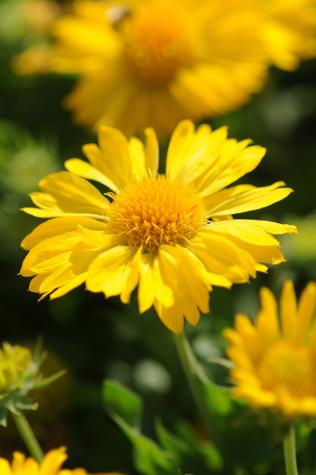COLUMBIA, Mo. – “While not a leading star on the herbaceous ornamental stage, Gaillardia can comfortably fill the supporting actor role in your garden,” said David Trinklein, state horticulture specialist for University of Missouri Extension.
Commonly called “blanket flower,” this colorful perennial produces daisy-like flowers that come in shades of yellow, orange, red, purplish, brown, white or bicolored.
Its flower is actually a compound inflorescence botanically known as a pseudanthium, or head, Trinklein added. What appear to be petals are really florets. The petal-like ray florets of this member of the sunflower plant family surround a tuft of disc florets in the center.
“Very characteristic of Gaillardia is that the ray florets are banded in color. The same color shows up on each floret in the same spot,” Trinklein said. “This produces very beautiful symmetry of color surrounding the center tuft of disc florets.”
Gaillardia is one of the few perennials that will bloom the first year when started from seed. “It will bloom most prolifically in early summer but then continues to produce a few flowers all the way to first frost,” he said.
Growing and caring for gaillardias is easy as long as you remember one important thing: no wet feet. “Gaillardia needs full sun and, most importantly, well-drained soil,” Trinklein said. “The need for well-drained soil is so great that if planted in heavy soils Gaillardia likely will not survive the winter.”
If you’re into xerophytic landscaping, using plants that get by on little water, Gaillardia would be a very colorful choice. “It’s relatively pest-free, heat-tolerant and doesn’t require a lot of added water,” Trinklein said.
You have plenty of options if you want to add gaillardias to your garden. There are some colorful older cultivars like “Goblin” that have been around for decades. “Newer cultivars tend to bear a few more flowers and come in a wide array of colors,” he said. “The ‘Mesa’ series of Gaillardia is a good example and is very free-flowering.”
“Fanfare,” a colorful new Gaillardia cultivar, has tubular ray florets that end with a trumpet-like flare, giving it a unique appearance. “Punch Bowl” and “Arizona Apricot” are recent cultivars that provide shades of red and apricot in a genus predominated by yellow and orange.
Photos
Gaillardia
Gaillardia 'Mesa Bright Bicolor.' Photo courtesy National Garden Bureau Inc.
Gaillardia
Gaillardia 'Mesa Yellow.' Photo courtesy National Garden Bureau Inc.

